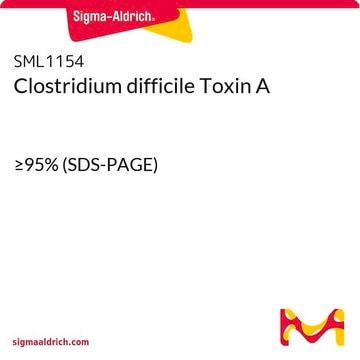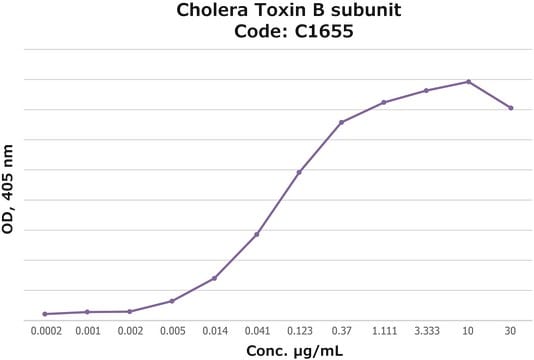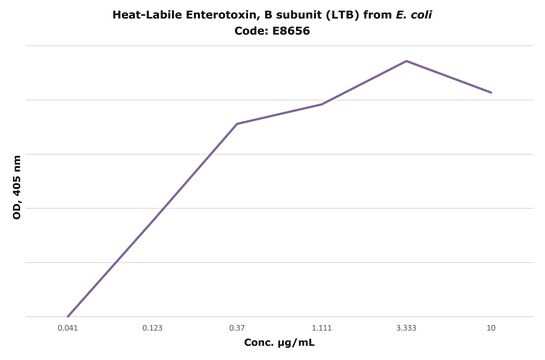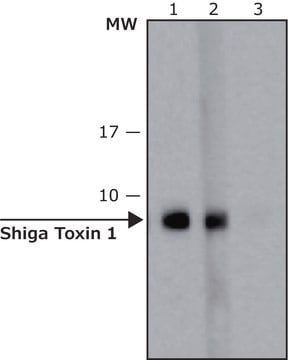SML0562
Shiga Toxin 1, B subunit
recombinant, expressed in E. coli, ≥95% (SDS-PAGE)
Sinónimos:
SLT1, STX1, STxB
Iniciar sesiónpara Ver la Fijación de precios por contrato y de la organización
About This Item
Código UNSPSC:
12352200
NACRES:
NA.77
Productos recomendados
recombinante
expressed in E. coli
Nivel de calidad
Análisis
≥95% (SDS-PAGE)
formulario
lyophilized
Condiciones de envío
dry ice
temp. de almacenamiento
−20°C
Aplicación
Shiga Toxin 1, B subunit has been used to induce globotriaosylceramide (Gb3) endocytosis.
Acciones bioquímicas o fisiológicas
The Shiga toxins are a family of related protein toxins secreted by certain types of bacteria. Shiga toxin (Stx) is produced by Shigella dysenteriae, whereas the Shiga-like toxins, Stx1 and Stx2, with a few known isoforms, are secreted by specific strains of Escherichia coli named Shiga-toxin-producing E. coli (STEC) such as E. coli O157:H7, which causes bloody diarrhea and hemorrhagic colitis in humans, sometimes resulting in fatal systemic complications.
Stx1 is identical to Stx, while the Stx2 isoforms share less sequence similarity with Stx (~60%) and are immunologically distinct. In spite of the differences in their amino acid sequence, all Stx isoforms share the same overall toxin structure and mechanism of action.
Shiga toxins consist of two polypeptides: An A chain and a B chain non-covalently associated with an apparent stoichiometry of one A and five B chains, to form the holotoxin. The catalytic A subunit has a RNA N-glycosidase activity that inhibits eukaryotic protein synthesis. The B subunits form a pentamer that recognizes and binds to the functional cell-surface receptor globotriaosylceramide [Gb3; Gala(1-4)-Galb(1-4)-Glcb1-ceramide]. Gb3 is overexpressed in membranes of numerous tumor cells, therefore STxB binding to Gb3 receptors may be useful for cell-specific vectorization, labeling and imaging purposes.
Stx1 is identical to Stx, while the Stx2 isoforms share less sequence similarity with Stx (~60%) and are immunologically distinct. In spite of the differences in their amino acid sequence, all Stx isoforms share the same overall toxin structure and mechanism of action.
Shiga toxins consist of two polypeptides: An A chain and a B chain non-covalently associated with an apparent stoichiometry of one A and five B chains, to form the holotoxin. The catalytic A subunit has a RNA N-glycosidase activity that inhibits eukaryotic protein synthesis. The B subunits form a pentamer that recognizes and binds to the functional cell-surface receptor globotriaosylceramide [Gb3; Gala(1-4)-Galb(1-4)-Glcb1-ceramide]. Gb3 is overexpressed in membranes of numerous tumor cells, therefore STxB binding to Gb3 receptors may be useful for cell-specific vectorization, labeling and imaging purposes.
Forma física
The recombinant product is Shiga toxin 1, B subunit, a 7 kDa protein containing 69 amino acid residues. It is lyophilized from 0.2 μm-filtered solution of phosphate buffer without any carrier protein.
Nota de preparación
Reconstitute the contents of the vial using water to a concentration of 0.1-1.0 mg/mL. This solution can then be further diluted into other aqueous buffers and stored at 2-8 °C for up to 4 months or at −20 °C for extended use.
Nota de análisis
Gb3 Binding activity: significant binding above background is achieved with ≤1 μg/mL of STxB. The activity of STxB is measured by its ability to bind to Gb3, which requires its pentameric form.
Código de clase de almacenamiento
13 - Non Combustible Solids
Clase de riesgo para el agua (WGK)
WGK 3
Punto de inflamabilidad (°F)
Not applicable
Punto de inflamabilidad (°C)
Not applicable
Certificados de análisis (COA)
Busque Certificados de análisis (COA) introduciendo el número de lote del producto. Los números de lote se encuentran en la etiqueta del producto después de las palabras «Lot» o «Batch»
¿Ya tiene este producto?
Encuentre la documentación para los productos que ha comprado recientemente en la Biblioteca de documentos.
Los clientes también vieron
Shruti Chaturvedi et al.
Blood, 135(4), 239-251 (2019-12-10)
The antiphospholipid syndrome (APS) is characterized by thrombosis and/or pregnancy morbidity in the presence of antiphospholipid antibodies, including anti-β2-glycoprotein-I (anti-β2GPI), that are considered central to APS pathogenesis. Based on animal studies showing a role of complement in APS-related clinical events
Jia Yu et al.
Haematologica (2021-07-23)
Severe acute respiratory syndrome coronavirus-2 (SARS-CoV-2) may manifest as thrombosis, stroke, renal failure, myocardial infarction, and thrombocytopenia, reminiscent of other complement-mediated diseases. Multiple clinical and preclinical studies have implicated complement in the pathogenesis of COVID-19 illness. We previously found that
Annette Brandel et al.
Cellular and molecular life sciences : CMLS, 78(7), 3637-3656 (2021-02-09)
The opportunistic pathogen Pseudomonas aeruginosa has gained precedence over the years due to its ability to develop resistance to existing antibiotics, thereby necessitating alternative strategies to understand and combat the bacterium. Our previous work identified the interaction between the bacterial
The Pseudomonas aeruginosa lectin LecA triggers host cell signalling by glycosphingolipid-dependent phosphorylation of the adaptor protein CrkII
Zheng S, et al.
Biochimica et Biophysica Acta, 1864(7), 1236-1245 (2017)
In-Sun Shin et al.
Chemical & pharmaceutical bulletin, 54(4), 522-527 (2006-04-06)
A two-step binding assay for globotriaosylceramide (Gb3) content was developed by histidine-tagging strategy, which is a well-established method for the purification of recombinant proteins. The complete binding of the recombinant His-tagged Shiga toxin 1B subunit (1B-His) (1 microg/ml) to the
Nuestro equipo de científicos tiene experiencia en todas las áreas de investigación: Ciencias de la vida, Ciencia de los materiales, Síntesis química, Cromatografía, Analítica y muchas otras.
Póngase en contacto con el Servicio técnico









